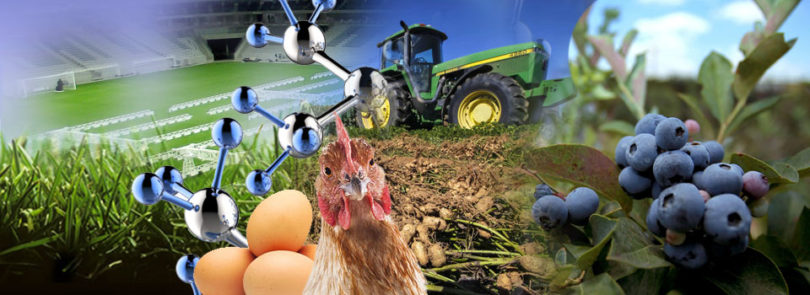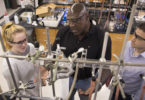For Wayne Hanna, the stars of the 2014 World Cup weren’t Mario Gotze, Tim Howard or Lionel Messi. They were TifGrand and Tifway 419, grasses that greened the playing fields of several Brazilian World Cup soccer stadiums. These two robust turfs belong to the Tifton Bermuda (“Tif”) family of grasses developed by a team of researchers, including Hanna, at the University of Georgia and the U.S. Department of Agriculture’s Agricultural Research Service in Tifton.
“TifGrand was tested on 25 locations in 19 states, and we had 16 years of testing,” says Hanna, a turf breeder with UGA, now retired from the USDA-ARS. “When you’re working with turf, you’ve got to be patient.”
Bred to flourish in drought, cold, shade and even a saltwater spray, the many Tifton Bermuda grass hybrids now dominate golf courses, sports stadiums and lawns throughout the world, from the largest golf facility on Earth (in Shenzhen, China) to Sanford Stadium here on campus. Sales of these grasses bring Georgia farmers revenue of $75 million annually, with an economic impact to the state that exceeds $1 billion.
The Tif grasses are just one part of a 35-year-old University of Georgia program-the Technology Commercialization Office-that transfers inventions and discoveries to industry, the marketplace and ultimately to consumers. Since its beginnings, this entity licensed research findings to partners in industry and helped generate hundreds of products for improving the lives of Georgians while greatly benefiting the regional economy. Peanuts, blueberries and hydrangeas, for example-all bred by UGA scientists-have generated hundreds of millions of dollars in sales, and vaccines developed at the university protect and enhance Georgia’s colossal poultry industry.
In 2013, some 400 TCO-granted licenses contributed $8.3 million in royalty revenue to the university, most of which was reinvested in the research enterprise. The money helps cover the costs of outfitting new labs, purchasing new equipment and providing seed grants to help fund early-stage research, among other uses.
While plants bred in the College of Agricultural and Environmental Sciences currently account for the majority of UGA license revenue, other emerging technologies, such as a patented platform to manufacture therapeutic proteins in eggs for use in treating rare diseases, hold great promise, says Derek Eberhart, director of TCO and the Georgia BioBusiness Center. Combining the two offices has “put everything under one umbrella to facilitate moving discoveries from labs and fields into the marketplace,” says Eberhart. “This arrangement will be more efficient and leverage the expertise of our team and network of partners.”
Turning the Peach State blue
UGA had a blueberry-breeding program long before anyone began to tout the tiny fruit as a nutritional powerhouse. Today, UGA-developed blueberries grow on every continent in the world save Antarctica, and Georgia grows and ships more blueberries than any other U.S. state. Several years ago, the blueberry passed the peach as the state’s No. 1 fruit crop.
In 1945, UGA horticulturist Tom Brightwell began tinkering with the rabbiteye blueberry, a Georgia native, and continued until he retired in the 1970s. For the last 25 years, UGA plant breeder Scott NeSmith has been improving Brightwell’s blueberry varieties-and creating new ones-in response to the needs of industry. Farmers want blueberries that can be harvested by machine, are pest- and disease-resistant, grow to a larger size so that harvesting is easier, and boast a longer shelf life.
The 13 UGA varieties developed and patented since 2001 have helped transform the blueberry industry from a $4 million enterprise in 1990 to the $250 million business it is today. NeSmith says that in 1990 there were fewer than 3,000 acres of blueberries in Georgia; today there are some 22,000 acres.
TCO secures intellectual property protection for the blueberry varieties, including patent and trademark protection. The licensing team issues IP rights to dozens of industry partners in Georgia and around the world, allowing them to propagate and sell the UGA varieties. Royalties are then reinvested in UGA research.
The cash cow of Georgia’s plant kingdom
Since 1951, the university has had a peanut-research program in Tifton, with plant breeders developing varieties that outshine those that came before.
The peanut varieties developed in Tifton have helped make the state the biggest producer of peanuts in the country, with a 2012 crop of 3.3 billion pounds and a farm gate value of $892 million. About half of Georgia peanuts are turned into peanut butter, says Bob Kemerait, a plant pathologist on UGA’s peanut team in Tifton.
The TCO team ensures that UGA varieties receive IP protection and then licenses the rights to peanut producers in Georgia and across the Southeast so they can reap the benefits from the elite varieties developed at UGA.
The various peanut varieties bring in the most revenue of any plant for the UGA Research Foundation, generating royalties of more than $3 million in 2013. And the peanuts themselves are the basis of an industry that pumps about $2 billion into the Georgia economy each year.
Fair winds for fowl
Over the years, UGA scientists, both in the College of Veterinary Medicine’s Poultry Diagnostic and Research Center, and in the College of Agricultural and Environmental Science’s poultry science department, have developed technologies and vaccines to help keep chickens healthy. And for good reason: The poultry industry in Georgia is a $28 billion enterprise.
One new vaccine, HatchPak Cocci III, prevents coccidia parasites from damaging and destroying a bird’s intestines; before the vaccine, it would sometimes wipe out an entire large flock. Scientist Lorraine Fuller says that she and colleague Larry McDougald, now retired, partnered with professionals from Merial (a global animal health company with North America headquarters in Duluth, Georgia) to work on the coccidiosis vaccine-a collaboration lasting 10 years.
The resulting HatchPak Cocci III is attenuated, Fuller says, meaning the vaccine contains parasites that have been rendered less virulent. Thus farmers who spray the vaccine on baby chicks don’t have to administer the typical long course of antibiotics to young birds to protect them from the debilitating disease.
Georgia Bio and the Metro Atlanta Chamber recently presented the Phoenix Award to UGA and Merial in recognition of a long-standing collaboration leading to worldwide contributions to animal health and significant economic impact in Georgia and beyond. The UGA-Merial partnership has produced more than 100 collaborations, ranging from exchange of materials, to sponsored research and license agreements. So far, four commercial poultry vaccines based on UGA technologies have generated over $2 million in royalty revenue.
A promising future
UGA’s technology commercialization and startup programs have built an enviable record, and Eberhart maintains that with the advent of exciting developments at the University of Georgia, the best is yet to come. “While it’s gratifying to reflect on past successes, we look forward to the opportunities provided by the expansion of UGA’s research programs, including the new College of Engineering and the Center for Molecular Medicine,” he says. “We’re excited about what the future will bring as we partner with UGA researchers and industry collaborators to build on the university’s legacy of providing innovative solutions to needs here in Georgia and around the world.”








